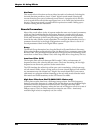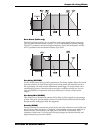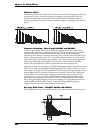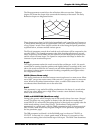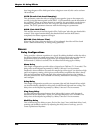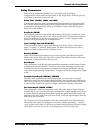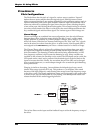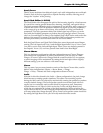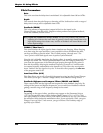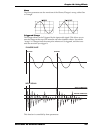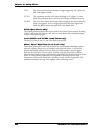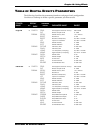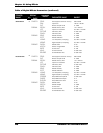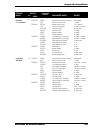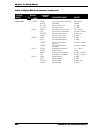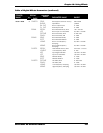
Chapter 10: Using Effects
224 ANDROMEDA A6 REFERENCE MANUAL
Pitch Parameters
Rate
This is the rate that the delay time is modulated. It is adjustable from 0.00 to 6.47Hz.
Depth
This controls how deep the flange or chorusing will be. It affects how wide a range of
delay time is swept, and is adjustable from 0-250.
Feedback (FDBK)
This is the amount of regeneration (output fed back to the input) in the
Chorus/Flanger, from -99 to 99%. Negative values produce out-of-phase feedback,
which has a thinner, hollow sound.
Rate, Depth and Feedback are always related, and you will probably find yourself
adjusting all of them at the same time. In general, slower rates sound better with
high depth settings than faster ones, and lots of feedback will sound better with
lower depth settings.
THRU0 ("Thru Zero")
This control delays the input signal to better simulate tape flanging. When flanging
was done using two tape machines, it was possible for one to be behind the other,
catch up and then go past the other. This is called passing “through zero”. The
“zero” point is when both signals were in perfect synchronization.
Since the A6 is digitally simulating the flanging effect, it normally cannot provide the
through zero effect. The “Thru0” parameter found in the A6’s flanging effects lets
you create the appearance of the effected signal passing through the zero point. It
does this by actually delaying the uneffected signal by as much as 12 milliseconds
(an amount virtually undetectable to the human ear). This allows the wet signal to
move “behind” the dry signal as it cycles. To hear this effect properly, the
MAIN OUT
of the program must be off.
Low Pass Filter (LPF)
This filter allows you to roll off any high frequencies going into the Chorus/Flanger.
This allows you to get a “warmer” flanger sound, or to simulate vintage effects.
Feedback Highpass and Lowpass Filters (FBHPF and FBLPF)
These controls filter out the high and low frequencies in the feedback loop only. By
rolling off the lowest and highest frequencies, you can add lots of feedback without
getting a metallic ring or low frequency thump to the sound.
Predelay
Depending on the type of effect, predelays may appear on the Parameter Strip as
1PDTIM (first predelay time of the 4-element Quad Chorus), LPDLY or RPDLY (left
and right predelay in a stereo chorus), and similar variables. In any case, this controls
the amount of delay before the modulation effect. If you set it below 15mS, you get a
Flanger. If you set it for 15 mS or more, you get a Chorus. The Predelay range is
typically up to 250mS.



